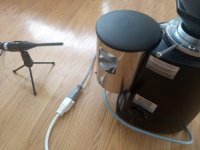Oh, quite different aroma from just ground to 12 (or 8) hours earlier.Isn't grinding into a sealable container the night before, an option?
Or is that a sin?
I mean, just how bad can that effect the next morning's brew?
Best "smell" components are quite volatile oils and evaporate in minutes, not kidding.
One way to minimize it is to grind on previous night, BUT:
1) keep unground beans in the fridge (not in the freezer) inside a hermetic container, think a glass jam bottle with tightly fitting metal cover.
2) grind just what you need for next morning out of the cold beans, keep in small separate container, same considerations, there are small jam/marmalade glass bottles, same construction as their larger sisters.
Keep these too in the fridge.
Keeping coffee cold all the time (until actual brewing that is) helps a lot.
EDIT: glass and metal are fine; forget plastic, it´s too porous to keep flavour in, and will contaminate new coffee beans and even more, grounds, with "old tenants" bad flavours, including rancid/humid/old coffee or simply different mix.
Last edited:
...
Suggestion 2:
and not kidding: you want fresh ground coffee plus independence from mains power?
Then look no further than:
Have you tried any of those hand grinders? Asking because I would like to buy a new coffee grinder and the hand operated ones seem very appealing. I mean why over complicate things if a simple hand grinder will do for a morning cup of coffee for the wife and myself.
Isn't keeping the beans cold the main advantage of hand ( ie slow ) grinding? 5 mins of round and round and round.... for one cup, or cheat and pop in a coffee bag. Who's the most pretentious, a coffee snob or audiophile? Does the build up of anticipation during the long process of beans to cup add more to the taste ( placebo effect ) than the process itself?
Ps I don't mean to be derogatory, each to their own.
Ps I don't mean to be derogatory, each to their own.
I agree with building a box with damping material inside that you put over your grinder, or why not make one out of meta material, like kefs new ls50 tweeter backchamber
I have an MACAP4 grinder. Flat plates and the grinder is doserless with a chute. The majority of the noise is transmitted through the feet to the worktop so that's where I would start.
Isn't grinding into a sealable container the night before, an option?
Or is that a sin?
I mean, just how bad can that effect the next morning's brew?
The coffee aficionado - it's the rule of 6. A limit of 6 months raw beans, 6 days from roasted (it takes 1-2 days for CO2 to escape the bean) and 6 minutes for freshly ground coffee.
I've recovered a little from that nonsense and use a Tassimo during the week - I still have the Electra Microcasa a leva (MCAL) and MACAP. The MCAL is extremely fussy about grind - to the point that dry/older beans will simply not have enough back pressure to prevent the water from gushing through the into the cup. It's the oils that cause the back pressure during the extraction.
Also doesn't help that I'm not particularly good with dairy later in life - a shame as the MCAL makes the best steamed milk I've even seen. It's literally like velvet.
Example of the MCAL at work.. Elektra Microcasa La Leva Espresso Shot - YouTube
Isn't keeping the beans cold the main advantage of hand ( ie slow ) grinding? 5 mins of round and round and round.... for one cup, or cheat and pop in a coffee bag. Who's the most pretentious, a coffee snob or audiophile? Does the build up of anticipation during the long process of beans to cup add more to the taste ( placebo effect ) than the process itself?
Ps I don't mean to be derogatory, each to their own.
Flat burrs work best - the grind occurs quickly without heating by the time the bean has gone from the inside to the outside edge.
The coffee grinder on my automatic expresso coffee brewing machine is enclosed in the machine itself, so I don't need to worry about grinding. It is a premium device designed in Switzerland by someone that had a lot of fun doing this, I guess, because it is way more complicated than most devices of this kind. That's the reason why I got it, actually, since I would never considered purchasing a coffee machine so expensive. It is a gift from a friend that was ready to bring it to the recycling center. It stopped working right after the warranty expired, and the repair was deemed impossible. There are 3 low voltage DC motors inside this machine. The first does operate the internal grinder; the second does move the piston that stuffs the grinded coffee into the brewing chamber, and also flushes the spent coffee on the waste bucket. The third does rotate the chamber from the grinding/filling position to the brewing/discharge position. There are several switches to sense the mechanical devices positions. The mainboard is big and filled with (comparatively) expensive parts. There is a USB service port concealed by a cap under the device. At power on, the machine flashed a service error code and stopped there. According to the user manual, this fault can only be repaired by the manufacturer. They probably use a proprietary software to connect the computer to the service port and diagnose and calibrate the unit. The design is service friendly, it is fairly easy to access the internal parts. All looked to be almost brand new and fine, except the brewing chamber: it was stuck halfway between the grinding and the brewing position. The firmware was reading an incorrect limit switches position at startup and was programmed to halt the operations without any attempt to move the motors. I powered off the machine, disconnected the motor from the mainboard, put a 9V battery on the motor wires to turn it fully to the grinding position, and reconenct the motor wire to the mainboard. This happened 2 years ago and the coffee machine is working flawlessly ever since. So it was a software fault, a unhandled status condition, and I guess how many perfectly good products are being scrapped due to this kind of issues.
That's because in Italy, it's quick and easy to get a good cup of cappuccino or espresso just across the street.I would never considered purchasing a coffee machine so expensive.
Oh, quite different aroma from just ground to 12 (or 8) hours earlier.
Best "smell" components are quite volatile oils and evaporate in minutes, not kidding.
One way to minimize it is to grind on previous night, BUT:
1) keep unground beans in the fridge (not in the freezer) inside a hermetic container, think a glass jam bottle with tightly fitting metal cover...
My Gosh - I've been doing everything Wrong! The things you can learn on DIYAudio!
I tried roasting at home years ago. Didnt know about the CO2 abdication after two days though - so I concluded there was no possible way I'd even come close to what the local roasters could do with their blends, so I quit the idea.
If I find a coffee roaster, I can usually get a decent $ for it on ebay. So often the T store people dont know what it is - and price accordingly. I found one at a yard sale when they were all backordered on Amazon - got top dollar that time!
Last edited:
If anyone has ideas on how to approach a noise reduction enclosure I am all ears.
Buy a can of SR500 and paint the whole thing with it.😀
SR 500 Industrial Sound Damping :: Silent Running
jeff
What's the SPL at one meter? The Mazzer has much less noise between 2 & 3kHz compared to the Baratza.
jeff
jeff
Last edited:
Both measurements. Mazzer sounds good. Baratza sounds terrible.
It's almost like a speaker! Spectrum does nothing to explain why one sounds good and the other sounds terrible 😉 "I must be measuring it wrong" - I wonder how many times that one's been considered in the more familiar context.
Keeping coffee cold all the time (until actual brewing that is) helps a lot.
EDIT: glass and metal are fine; forget plastic, it´s too porous to keep flavour in, and will contaminate new coffee beans and even more, grounds, with "old tenants" bad flavours, including rancid/humid/old coffee or simply different mix.
I've roasted coffee then stored it in glass mason jars in the freezer after allowing CO2 to outgas and push the oxygen out. It saved for at least six months exactly as if it was just roasted. I'm certain it would have remained fresh indefinitely as long as it remained frozen. Can't get freezer burn because there's no moisture left after roasting.
I can also throw frozen beans straight into the grinder without trying to thaw them out. Glass + freezer (or a fridge if you aren't storing long term) is a great way to store coffee.
What's the SPL at one meter? The Mazzer has much less noise between 2 & 3kHz compared to the Baratza.
jeff
Thanks for pointing that out. I don't have an eye for those things.
I do not know the SPL at one meter. I'll redo the measurements again. Not today though because it's sunny and we don't get that very often in the winter.
- Home
- General Interest
- Everything Else
- Coffee Grinder Enclosure (Noise Reduction)




